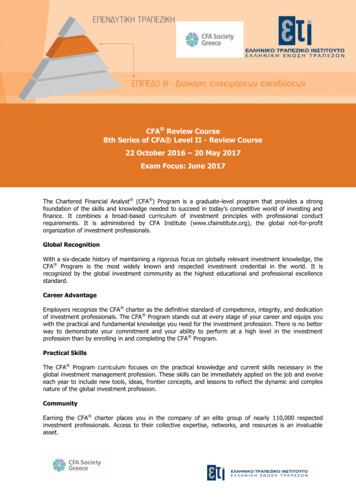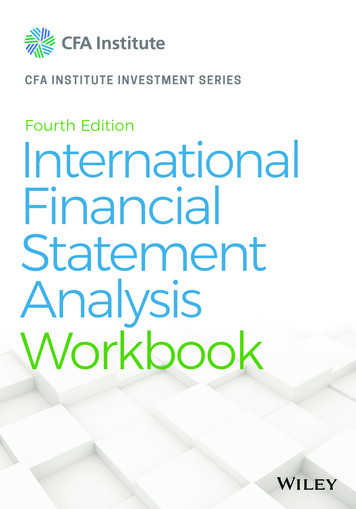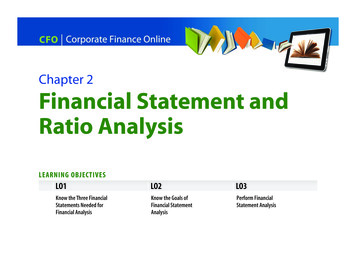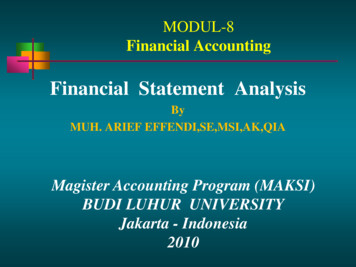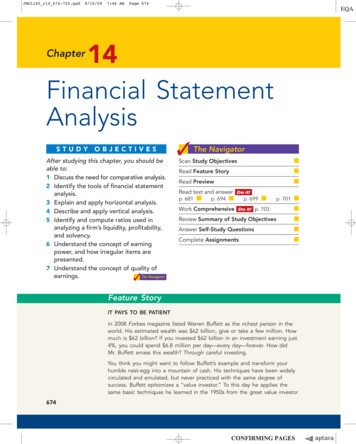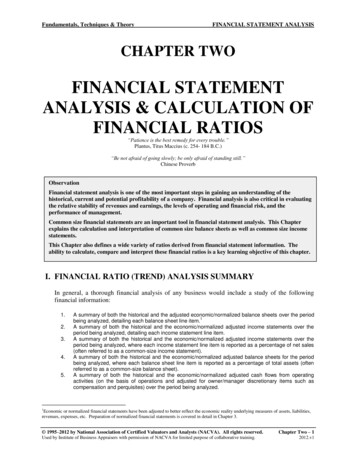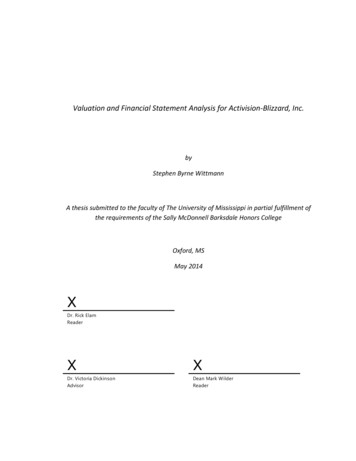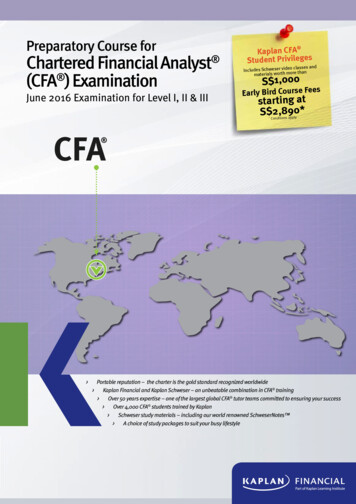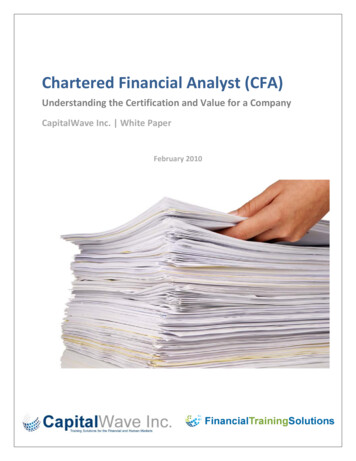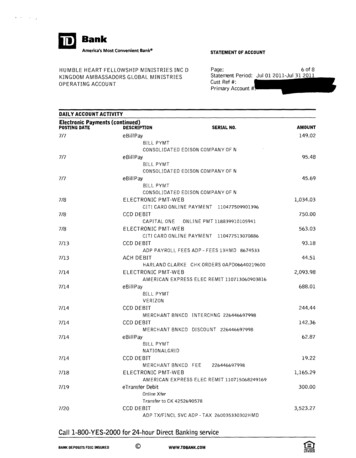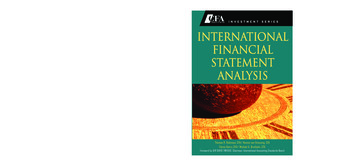
Transcription
(continued from front flap)well as concise learning outcome statements andsummary chapter overviews.THOMAS R. ROBINSON, CFA, is Managing Director, Education Division of CFA Institute, wherehe leads and develops the teams responsible forproducing and delivering educational content andexaminations to candidates, members, and otherinvestment professionals encompassing the CFAProgram, CIPM Program, Lifelong Learning, PrivateWealth, Publications, and Conferences.HENNIE van GREUNING, CFA, is a Senior Advisorat the World Bank. His World Bank publication onInternational Financial Reporting Standards has appeared in four editions. Mr. van Greuning has alsocoauthored Analyzing and Managing Banking Risk.ELAINE HENRY, CFA, is an Assistant Professor ofAccounting at the University of Miami, where sheteaches courses in accounting, financial statementanalysis, and valuation. After working in corporatefinance at Lehman Brothers, strategy consulting atMcKinsey & Company, and corporate banking atCitibank, she obtained a PhD from Rutgers University where she majored in accounting and minoredin finance.MICHAEL A. BROIHAHN, CFA, is an AssociateProfessor of Accounting and the Director of Graduate Programs at Barry University in Miami, Florida.His teaching and research interests encompassfinancial accounting, auditing, and professionalethics. He currently serves CFA Institute in a number of capacities.Jacket Design: Loretta LeivaJacket Illustration: Getty ImagesPRAISE FORINTERNATIONAL FINANCIALSTATEMENT ANALYSIS“International Financial Statement Analysis is arriving on the scene at the right time with anew and useful orientation and comprehensive coverage. It should be an importantand valuable resource.”—GARY JOHN PREVITS, E. Mandell de Windt Professor,Case Western Reserve University“This text is the basis for analyzing and interpreting financial statements of companiesaround the globe and appeals to both the student and seasoned investor. It is anessential read and reference book for the global investor in search of alpha.”—CHRIS SENYEK, CFA, CPA, Managing Director–Accounting & Tax PolicyResearch, ISI Group, Inc.“This text is a valuable addition to the financial statement analysis literature with itsemphasis on financial reporting from an IFRS perspective, while highlighting majordifferences between IFRS and U.S. GAAP throughout. With IFRS rapid global adoption,it provides a financial statement analysis foundation for analysts globally who will becomparing IFRS and U.S. GAAP financial statements in the coming years as convergence continues. The authors’ integration of the IFRS framework throughout the textis particularly noteworthy, since it is the first source of guidance that professionalsutilize when applying IFRS in practice.”—DAVID R. CAMPBELL SR., Professor of Accounting, Drexel UniversityDon’t forget to pick up the International Financial Statement Analysis Workbook.A companion study guide that mirrors this text chapter by chapter.International FinancialStatement AnalysisStraightforward and accessible, International FinancialStatement Analysis provides you with the continuityof topic coverage that is so critical to the learningprocess. Filled with in-depth insights and expertadvice, this practical guide offers a detailed look athow financial statement analysis can be understoodin a global context and applied around the world.Robinsonvan GreuningHenryBroihahn 95.00 USA/ 105.00 CAN@ E M JK D E K J I @ JINTERNATIONALFINANCIALSTATEMENTANALYSISThe process of financial statement analysisallows you to gain important insights intothe true financial condition of a company.With it, realistic valuations can be made for investment, lending, or merger and acquisition purposes.While this discipline has increased in complexity—especially on an international level—there are waysto deal with the practical challenges you’ll face.As part of the CFA Institute Investment Series,International Financial Statement Analysis has beendesigned to help you effectively evaluate financialstatements in today’s volatile markets and uncertain global economy.With International Financial Statement Analysis,the distinguished team of Thomas Robinson,Hennie van Greuning, Elaine Henry, and MichaelBroihahn—together with a number of experiencedcontributors—provides you with complete coverage of the most important issues in this field.Written with both the established and aspiringfinancial professional in mind, this book will helpyou understand the mechanics of the accountingprocess, which is the foundation for financialreporting; comprehend the differences and similarities in income statements, balance sheets, and cashflow statements around the globe; and assess theimplications for securities valuation of any financialstatement element or transaction. You’ll also discover how different financial analysis techniques—such as ratio analysis and common-size financialstatements—can provide valuable clues into acompany’s operations and risk characteristics.Along the way, you’ll also become familiar withmany other essential aspects of this discipline,including the importance of income tax accountingand reporting, the difficulty of measuring the valueof employee compensation, and the impact of foreign exchange rates on the financial statements ofa multinational corporation.K fdXj I% IfY ejfe# : 8& ?\ee \ mXe i\le e # : 8 cX e\ ?\eip# : 8& D Z X\c 8% 9if X e# : 8 fi\nfi[ Yp J@I ;8M@; KN ;@ # : X idXe# @ek\ieXk feXc 8ZZflek e JkXe[Xi[j 9fXi[And to enhance your understanding of the toolsand techniques presented here, don’t forget topick up the International Financial Statement AnalysisWorkbook. This companion guide contains carefullyconstructed problems with detailed solutions as(continued on back flap)
ffirs.indd i9/17/08 12:47:45 PM
INTERNATIONALFINANCIALSTATEMENTANALYSISffirs.indd i9/17/08 12:47:45 PM
CFA Institute is the premier association for investment professionals aroundthe world, with over 95,000 members in 134 countries. Since 1963 the organization has developed and administered the renowned Chartered FinancialAnalyst Program. With a rich history of leading the investment profession,CFA Institute has set the highest standards in ethics, education, and professional excellence within the global investment community, and is the foremost authority on investment profession conduct and practice.Each book in the CFA Institute Investment Series is geared toward industry practitioners, along with graduate-level finance students, and covers themost important topics in the industry. The authors of these cutting-edgebooks are themselves industry professionals and academics and bring theirwealth of knowledge and expertise to this series.ffirs.indd ii9/17/08 12:47:46 PM
INTERNATIONALFINANCIALSTATEMENTANALYSISThomas R. Robinson, CFAHennie van Greuning, CFAElaine Henry, CFAMichael A. Broihahn, CFAJohn Wiley & Sons, Inc.ffirs.indd iii9/17/08 12:47:46 PM
Copyright 2009 by CFA Institute. All rights reserved.Published by John Wiley & Sons, Inc., Hoboken, New Jersey.Published simultaneously in Canada.No part of this publication may be reproduced, stored in a retrieval system, or transmitted in any form or by anymeans, electronic, mechanical, photocopying, recording, scanning, or otherwise, except as permitted under Section107 or 108 of the 1976 United States Copyright Act, without either the prior written permission of the Publisher, orauthorization through payment of the appropriate per-copy fee to the Copyright Clearance Center, Inc., 222 RosewoodDrive, Danvers, MA 01923, (978) 750-8400, fax (978) 750-4470, or on the web at www.copyright.com. Requests tothe Publisher for permission should be addressed to the Permissions Department, John Wiley & Sons, Inc., 111 RiverStreet, Hoboken, NJ 07030, (201) 748-6011, fax (201) 748-6008, or online at http://www.wiley.com/go/permissions.Limit of Liability/Disclaimer of Warranty: While the publisher and authors have used their best efforts in preparingthis book, they make no representations or warranties with respect to the accuracy or completeness of the contentsof this book and specifically disclaim any implied warranties of merchantability or fitness for a particular purpose.No warranty may be created or extended by sales representatives or written sales materials. The advice and strategiescontained herein may not be suitable for your situation. You should consult with a professional where appropriate.Neither the publisher nor author shall be liable for any loss of profit or any other commercial damages, includingbut not limited to special, incidental, consequential, or other damages.For general information on our other products and services or for technical support, please contact our CustomerCare Department within the United States at (800) 762-2974, outside the United States at (317) 572-3993, orfax (317) 572-4002.Wiley also publishes its books in a variety of electronic formats. Some content that appears in print may not beavailable in electronic books. For more information about Wiley products, visit our web site at www.wiley.com.Library of Congress Cataloging-in-Publication Data:International financial statement analysis / Thomas R. Robinson . . . [et al.].p. cm.—(CFA Institute investment series)Includes index.ISBN 978-0-470-28766-8 (cloth)1. Financial statements. 2. International business enterprises—Accounting.HF5681.B2I5788 2008657'.3—dc22I. Robinson, Thomas R.2008014644Printed in the United States of America10 9 8 7 6 5 4 3 2 1ffirs.indd iv9/17/08 12:47:47 PM
CHAPTER 1Financial Statement Analysis: An IntroductionLearning Outcomes1. Introduction2. Scope of Financial Statement Analysis3. Major Financial Statements and Other Information Sources3.1. Financial Statements and Supplementary Information3.2. Other Sources of Information4. Financial Statement Analysis Framework4.1. Articulate the Purpose and Context of Analysis4.2. Collect Data4.3. Process Data4.4. Analyze/Interpret the Processed Data4.5. Develop and Communicate Conclusions/Recommendations4.6. Follow Up5. SummaryPractice ProblemsCHAPTER 2Financial Reporting MechanicsLearning Outcomes1. Introduction2. The Classification of Business Activities3. Accounts and Financial Statements3.1. Financial Statement Elements and Accounts3.2. Accounting 25252626272830vftoc.indd v9/17/08 12:48:13 PM
viContents4. The Accounting Process4.1. An Illustration4.2. The Accounting Records4.3. Financial Statements5. Accruals and Valuation Adjustments5.1. Accruals5.2. Valuation Adjustments6. Accounting Systems6.1. Flow of Information in an Accounting System6.2. Debits and Credits7. Using Financial Statements in Security Analysis7.1. The Use of Judgment in Accounts and Entries7.2. Misrepresentations8. SummaryPractice ProblemsAppendix 2A: A Debit/Credit Accounting SystemCHAPTER 3Financial Reporting StandardsLearning Outcomes1. Introduction2. The Objective of Financial Reporting3. Financial Reporting Standard-Setting Bodies and Regulatory Authorities3.1. International Accounting Standards Board3.2. International Organization of Securities Commissions3.3. Capital Markets Regulation in Europe3.4. Capital Markets Regulation in the United States4. Convergence of Global Financial Reporting Standards5. The International Financial Reporting Standards Framework5.1. Objective of Financial Statements5.2. Qualitative Characteristics of Financial Statements5.3. Constraints on Financial Statements5.4. The Elements of Financial Statements5.5. General Requirements for Financial Statements6. Comparison of IFRS with Alternative Reporting Systems6.1. U.S. GAAP6.2. Implications of Other Reporting Systems6.3. Reconciliation of Financials Prepared According to Different Standards7. Effective Financial Reporting7.1. Characteristics of an Effective Financial Reporting Framework7.2. Barriers to a Single Coherent Framework8. Monitoring Developments in Financial Reporting Standards8.1. New Products or Types of Transactions8.2. Evolving Standards and the Role of CFA Institute8.3. Company Disclosures9. SummaryPractice Problemsftoc.indd 109/17/08 12:48:14 PM
ContentsCHAPTER 4Understanding the Income StatementLearning Outcomes1. Introduction2. Components and Format of the Income Statement3. Revenue Recognition3.1. General Principles3.2. Revenue Recognition in Special Cases3.3. Implications for Financial Analysis4. Expense Recognition4.1. General Principles4.2. Issues in Expense Recognition4.3. Implications for Financial Analysis5. Nonrecurring Items and Nonoperating Items5.1. Discontinued Operations5.2. Extraordinary Items5.3. Unusual or Infrequent Items5.4. Changes in Accounting Standards5.5. Nonoperating Items: Investing and Financing Activities6. Earnings Per Share6.1. Simple versus Complex Capital Structure6.2. Basic EPS6.3. Diluted EPS7. Analysis of the Income Statement7.1. Common-Size Analysis of the Income Statement7.2. Income Statement Ratios8. Comprehensive Income9. SummaryPractice ProblemsCHAPTER 5Understanding the Balance SheetLearning Outcomes1. Introduction2. Components and Format of the Balance Sheet2.1. Structure and Components of the Balance Sheet2.2. Format of the Balance Sheet3. Measurement Bases of Assets and Liabilities3.1. Current Assets3.2. Current Liabilities3.3. Tangible Assets3.4. Intangible Assets3.5. Financial Instruments: Financial Assets and Financial Liabilities4. Equity4.1. Components of Equity4.2. Statement of Changes in Shareholders’ Equityftoc.indd 661671701771811841871871921941941969/17/08 12:48:15 PM
viii5. Uses and Analysis of the Balance Sheet5.1. Common-Size Analysis of the Balance Sheet5.2. Balance Sheet Ratios6. SummaryPractice ProblemsCHAPTER 6Understanding the Cash Flow StatementLearning Outcomes1. Introduction2. Components and Format of the Cash Flow Statement2.1. Classification of Cash Flows and Noncash Activities2.2. A Summary of Differences between IFRS and U.S. GAAP2.3. Direct and Indirect Cash Flow Formats for ReportingOperating Cash Flow3. The Cash Flow Statement: Linkages and Preparation3.1. Linkages of the Cash Flow Statement with theIncome Statement and Balance Sheet3.2. Steps in Preparing the Cash Flow Statement3.3. Conversion of Cash Flows from the Indirect to the Direct Method4. Cash Flow Statement Analysis4.1. Evaluation of the Sources and Uses of Cash4.2. Common-Size Analysis of the Statement of Cash Flows4.3. Free Cash Flow to the Firm and Free Cash Flow to Equity4.4. Cash Flow Ratios5. SummaryPractice ProblemsCHAPTER 7Financial Analysis TechniquesLearning Outcomes1. Introduction2. The Financial Analysis Process2.1. The Objectives of the Financial Analysis Process2.2. Distinguishing between Computations and Analysis3. Analysis Tools and Techniques3.1. Ratios3.2. Common-Size Analysis3.3. The Use of Graphs as an Analytical Tool3.4. Regression Analysis4. Common Ratios Used in Financial Analysis4.1. Interpretation and Context4.2. Activity Ratios4.3. Liquidity Ratios4.4. Solvency Ratiosftoc.indd 642652702752762762772782842889/17/08 12:48:15 PM
Contents4.5. Profitability Ratios4.6. Integrated Financial Ratio Analysis5. Equity Analysis5.1. Valuation Ratios5.2. Industry-Specific Ratios5.3. Research on Ratios in Equity Analysis6. Credit Analysis6.1. The Credit Rating Process6.2. Research on Ratios in Credit Analysis7. Business and Geographic Segments7.1. IAS 14 Requirements7.2. Segment Ratios8. Model Building and Forecasting9. SummaryPractice 315CHAPTER 8International Standards Convergence323Learning Outcomes1. Introduction2. The IFRS Framework2.1. Key Aspects of the IFRS Framework2.2. Challenges in Financial Statement Preparation: Timing and Amounts3. The Balance Sheet3.1. Marketable Securities3.2. Inventories3.3. Property, Plant, and Equipment3.4. Long-Term Investments3.5. Goodwill3.6. Intangible Assets Other than Goodwill3.7. Provisions (Nonfinancial Liabilities)4. The Income Statement4.1. Revenue Recognition: General4.2. Revenue Recognition for Construction Contracts4.3. Cost of Sales4.4. Administrative Expenses (Including Employee Benefits)4.5. Depreciation Expenses4.6. Finance Costs4.7. Income Tax Expense4.8. Nonrecurring Items5. The Cash Flow Statement6. Standard Setters’ Agenda for Convergence7. Effect of Differences Between Accounting Standards8. SummaryPractice Problemsftoc.indd 373373373373383383393393403413443459/17/08 12:48:16 PM
xContentsCHAPTER 9Financial Statement Analysis: ApplicationsLearning Outcomes1. Introduction2. Application: Evaluating Past Financial Performance3. Application: Projecting Future Financial Performance3.1. Projecting Performance: An Input to Market-Based Valuation3.2. Projecting Multiple-Period Performance4. Application: Assessing Credit Risk5. Application: Screening for Potential Equity Investments6. Analyst Adjustments to Reported Financials6.1. A Framework for Analyst Adjustments6.2. Analyst Adjustments Related to Investments6.3. Analyst Adjustments Related to Inventory6.4. Analyst Adjustments Related to Property, Plant, and Equipment6.5. Analyst Adjustments Related to Goodwill6.6. Analyst Adjustments Related to Off-Balance-Sheet Financing7. SummaryPractice ProblemsCHAPTER 10InventoriesLearning Outcomes1. Introduction2. Inventory Cost and Inventory Accounting Methods2.1. Determination of Inventory Cost2.2. Declines in Inventory Value2.3. Inventory Accounting Methods2.4. Comparison of Inventory Accounting Methods3. Financial Analysis of Inventories3.1. Inventory Ratios3.2. Financial Analysis Illustration4. LIFO Accounting Method Under U.S. GAAP4.1. The LIFO Method4.2. LIFO Reserve4.3. LIFO Liquidations4.4. Inventory Financial Note Disclosures5. Effects of Inventory Method Choice5.1. Financial Statement Effects of Using LIFO5.2. Inventory Method Changes6. SummaryPractice Problemsftoc.indd 413413414414415416CHAPTER 11Long-Lived Assets419Learning Outcomes1. Introduction4194209/17/08 12:48:17 PM
Contents2. Accounting for the Acquisition of Long-Lived Tangible Assets2.1. Accounting Standards Related to Capitalization of Expenditures2.2. Costs Incurred at Acquisition2.3. Capitalization of Interest Costs3. Accounting for the Acquisition of Long-Lived Intangible Assets3.1. Intangible Assets Purchased in Situations Other thanBusiness Combinations3.2. Intangible Assets Developed Internally3.3. Intangible Assets Acquired in a Business Combination4. Depreciating Long-Lived Tangible Assets4.1. Depreciation Methods4.2. Estimates Required for Depreciation Calculations4.3. Using Fixed Asset Disclosures to Compare Companies’Average Age of Depreciable Assets5. Amortizing Intangible Assets with Finite Useful Lives5.1. Amortizing Intangible Assets with Finite Useful Lives5.2. Estimates Required for Amortization Calculations6. Asset Retirement Obligations7. Disposal of Long-Lived Operating Assets7.1. Sale of Long-Lived Assets7.2. Long-Lived Assets Disposed of Other than by a Sale8. Impairment of Long-Lived Assets8.1. Impairment of Long-Lived Tangible Assets Held for Use8.2. Impairment of Intangible Assets with a Finite Life8.3. Impairment of Goodwill and Other Intangibles with Indefinite Lives8.4. Impairment of Long-Lived Assets Held for Sale8.5. Reversals of Impairments of Long-Lived Assets8.6. Implications for Financial Statement Analysis9. Revaluation of Long-Lived Assets10. SummaryPractice ProblemsCHAPTER 12Income TaxesLearning Outcomes1. Introduction2. Differences Between Accounting Profit and Taxable Income2.1. Current Tax Assets and Liabilities2.2. Deferred Tax Assets and Liabilities3. Determining the Tax Base of Assets and Liabilities3.1. Determining the Tax Base of an Asset3.2. Determining the Tax Base of a Liability3.3 Changes in Income Tax Rates4. Temporary and Permanent Differences Between Taxable and Accounting Profit4.1. Taxable Temporary Differences4.2. Deductible Temporary Differences4.3. Examples of Taxable and Deductible Temporary Differences4.4. Temporary Differences at Initial Recognition of Assets and Liabilitiesftoc.indd 4704714724764764784794814814824824849/17/08 12:48:17 PM
xiiContents4.5.4.6.Business Combinations and Deferred TaxesInvestments in Subsidiaries, Branches, and Associates andInterests in Joint Ventures5. Unused Tax Losses and Tax Credits6. Recognition and Measurement of Current and Deferred Tax6.1. Recognition of a Valuation Allowance6.2. Recognition of Current and Deferred Tax Charged Directly to Equity7. Presentation and Disclosure8. Comparision of IFRS and U.S. GAAP9. SummaryPractice ProblemsCHAPTER 13Long-Term Liabilities and LeasesLearning Outcomes1. Introduction2. Bonds Payable2.1. Accounting for Bond Issuance2.2. Accounting for Bond Amortization, Interest Expense,and Interest Payments2.3. Debt Extinguishment2.4. Debt Covenants2.5. Presentation and Disclosure of Long-Term Debt2.6. Current Market Rates and Fair Values3. Debt with Equity Features3.1. Convertible Debt3.2. Debt with Warrants3.3. Financial Instruments with Characteristics of Both Debt and Equity4. Leases4.1. Advantages of Leasing4.2. Finance (or Capital) Leases versus Operating Leases5. Other Types of Off-Balance-Sheet Financing5.1. Take-or-Pay and Throughput5.2. Sale of Receivables6. SummaryPractice ProblemsCHAPTER 14Employee Compensation: Postretirement and Share-BasedLearning Outcomes1. Introduction2. Pensions and Other Postretirement Benefits2.1. Types of Postretirement Benefit Plans and the Implicationsfor Financial Reports2.2. Measuring a Defined-Benefit Pension Plan’s Liabilities2.3. Measuring a Defined-Benefit Pension Plan’s Periodic Costsftoc.indd 555555565565565595609/17/08 12:48:18 PM
ContentsFinancial Statement Reporting of Pension andOther Postretirement Benefits2.5. Evaluating Disclosures of Pension and Other Postretirement Benefits3. Share-Based Compensation3.1. Stock Grants3.2. Stock Options3.3. Other Issues Related to Share-Based Compensation4. SummaryPractice Problemsxiii2.4.CHAPTER 15Intercorporate InvestmentsLearning Outcomes1. Introduction2. Basic Corporate Investment Categories3. Minority Passive Investments3.1. Held-to-Maturity Investments3.2. Held-for-Trading Securities3.3. Available-for-Sale Investments3.4. Designated Fair Value4. Minority Active Investments4.1. Equity Method of Accounting: Basic Principles4.2. Investment Costs that Exceed the Book Value of the Investee4.3. Amortization of Excess Purchase Price4.4. Impairment4.5. Transactions with Associates4.6. Disclosure4.7. Issues for Analysts5. Joint Ventures6. Controlling Interest Investments6.1. Pooling of Interests6.2. Purchase Method6.3. Impact of Pooling of Interests versus Purchase Method onFinancial Statements: Date of Acquisition6.4. Impact of Pooling of Interests versus Purchase Method onFinancial Statements: Post-Acquisition6.5. Consolidated Financial Statements6.6. Financial Statement Presentation Subsequent to theBusiness Combination6.7. Goodwill6.8. Goodwill Impairment6.9. Purchase Price Less than Fair Value (Bargain Purchase)6.10. Additional Issues in Business Combinations that Impair Comparability6.11. Proposed Joint Project of the IASB and FASB7. Variable Interest and Special Purpose Entities7.1. Illustration of an SPE for a Leased Asset7.2. Securitization of Assetsftoc.indd 6366386386406406406426436449/17/08 12:48:18 PM
xivContents7.3. Qualifying Special Purpose Entities7.4. Consolidated versus Nonconsolidated Securitization Transactions8. SummaryPractice ProblemsCHAPTER 16Multinational OperationsLearning Outcomes1. Introduction2. Foreign Currency Transactions2.1. Foreign Currency Transaction Exposure to Foreign Exchange Risk2.2. Analytical Issues2.3. Disclosures Related to Foreign Currency Transaction Gains and Losses3. Translation of Foreign Currency Financial Statements3.1. Translation Conceptual Issues3.2. Translation Methods3.3. Illustration of Translation Methods (ExcludingHyperinflationary Economies)3.4. Translation Analytical Issues3.5. Translation When a Foreign Subsidiary Operates in aHyperinflationary Economy3.6. Companies Use Both Translation Methods at the Same Time3.7. Disclosures Related to Translation Methods4. SummaryPractice ProblemsCHAPTER 17Evaluating Financial Reporting QualityLearning Outcomes1. Introduction2. Discretion in Accounting Systems2.1. Distinguishing Cash Basis from Accrual Basis Accounting2.2. Placing Accounting Discretion in Context2.3. Manipulation Incentives2.4. Mechanisms Disciplining Management3. Financial Reporting Quality: Definitions, Issues, and Aggregate Measures3.1. Mean Reversion in Earnings3.2. Measures of the Accrual Component of Earnings and Earnings Quality3.3. Applying the Simple Measures of Earnings Quality4. A Framework for Identifying Low-Quality Financial Reporting4.1. Revenue Recognition Issues4.2. Expense Recognition Issues4.3. Balance Sheet Issues4.4. Cash Flow Statement Issues4.5. A Summary of Financial Reporting Quality Warning Signsftoc.indd 437507517617737777799/17/08 12:48:18 PM
Contentsftoc.indd xvxv5. The Implications of Fair Value Reporting for FinancialReporting Quality: A Brief Discussion6. SummaryPractice Problems782782783Glossary789References803About the Authors807About the CFA Program811Index8139/17/08 12:48:19 PM
ftoc.indd xvi9/17/08 12:48:19 PM
FOREWORDInvestors now routinely scour the globe looking for diversification and investment opportunities. At the same time they seek new and profitable opportunities, the economies inwhich they invest directly benefit from greater access to capital for development and growth,and from a lower and more competitive cost of capital. Because of the benefits to cross-borderinvestors and economies alike, the increasing globalisation of securities markets and capital islikely to be a defining hallmark of the twenty-first century.Although globalisation has been gradually increasing for many years, the final buildingblocks—the infrastructure necessary to ensure both free and unfettered movements of capitalacross borders and the investor protections required to support the flows—are just now beingput in place. They include cross-border stock exchanges, financial institutions with global reachthat can facilitate the efficient movement of capital from investors to companies, and the gradual development of cooperative arrangements among global regulators essential for the monitoring, oversight, and enforcement of consistent regulations and standards for investment.However, among the most critical and urgent of these changes is the development of acommon financial reporting standard, really a common language applicable and understandable across the globe, and the importance of a single, high-quality standard cannot be overstated. The effective functioning of capital markets and the economic benefits that they couldbring depend largely on the investors who participate in those markets. It is investors whomust interpret financial information, who evaluate the potential risks and rewards of investments, and who ultimately make investment decisions.In the absence of such a standard, the barriers to free movement of capital to those whomost need it and can most efficiently use it can be formidable. Investors, both large institutions and individuals, are required to invest large sums of resources to try to compensate,if they can do so at all. Their efforts must include not only understanding the language inwhich the financial reports are prepared but also gaining expert knowledge in the local GAAPstandards and their idiosyncrasies, as well as attempts to try to transform the various reporting systems into a consistent and comparable format for the comparison of various investment opportunities with the limited patchwork of information available. The attractivenessof a single, high-quality standard is immediately apparent.Although accounting standards are written with these global investors in mind, historically they have varied widely across borders because of the existence of differing accountingand enforcement regimes. Our goal at the International Accounting Standards Board (IASB)is to develop accounting principles that will span borders and require a company, whether inNew York, London, Tokyo, Mumbai, or Shanghai, to report a transaction in the same way. Inthis way, we aim to enable investors and other decision makers to make informed judgementsand to allocate capital efficiently, wherever they are based.The establishment of a single set of high-quality accounting standards used throughoutthe world’s capital markets would greatly assist in the analysis and comparison of financialxviifbetw.indd xvii9/17/08 12:48:46 PM
xviiiForewordinformation. For investors, the good news is that within just seven years of the IASB’s establishment, International Financial Reporting Standards (IFRSs) are now permitted or requiredby over 100 countries around the world, with the remaining major economies following apath toward convergence and adoption. The adoption of IFRSs, combined with rigorous audits and effective enforcement regimes, should serve as the basis of a sound financialreporting infrastructure for
2. Scope of Financial Statement Analysis 2 3. Major Financial Statements and Other Information Sources 5 3.1. Financial Statements and Supplementary Information 6 3.2. Other Sources of Information 16 4. Financial Statement Analysis Framework 18 4.1. Articulate the Purpose and Context of Analysis

